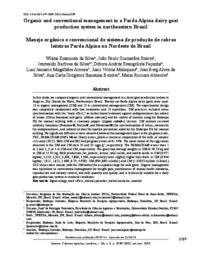Organic and conventional management in a Parda Alpina dairy goat production system in northeastern Brazil.
Organic and conventional management in a Parda Alpina dairy goat production system in northeastern Brazil.
Author(s): SILVA, W. E. da; SOARES, J. P. G.; SILVA, J. B. da; FAÇANHA, D. A. E.; AROEIRA, L. J. M.; MALAQUIAS, J. V.; SILVA, J. B. A. da; BEZERRA, A. C. D. S.; ABRANTES, M. R.
Summary: ABSTRACT: In this study, we compared organic and conventional management in a dairy goat production system in Angicos, Rio Grande do Norte, Northeastern Brazil. Twenty-six Parda Alpina dairy goats were used: 13 in organic management (OM) and 13 in conventional management (CM). The experimental design was completely randomized with two treatments and 13 repetitions. OM practices included estrus synchronization with the “male effect,” an herbal-based treatment against endoparasitoses (an extract of lemon [Citrus limonum] and garlic [Allium sativum]) and the control of mastitis using the Embrapa Kit for manual milking with a rosemary pepper (Lippia sidoides) tincture. CM animals received synthetic hormones (Promone®, Prolise®, and Novormon®) for synchronization of estrus, ivermectin for endoparasitoses, and iodized alcohol for mastitis prevention aided by the Embrapa Kit for manual milking. No significant differences were observed between the management types in the pregnancy rate, FEC, FAMACHA© (Faffa Malan Chart) scores, physico-chemical composition of the milk, or somatic cell count (SCC). Both OM and MC had pregnancy rates of 61.54%. The mean values of the egg counts observed in the OM and CM were 24 and 35 eggs g-1, respectively. The FAMACHA© scores were 1 or 2 and 2, 3, or 4 in OM and CM, respectively. The goats had average weights in OM of 48.53 kg and in CM of 55.92 kg. Milk production, fat, protein, lactose, total solids, and nonfat solids in OM (0.971 kg/day, 2,210, 2,322, 3,306, 7,866, 5,566, respectively) were slightly higher than those in CM (0.946 kg/day, 1,812, 1,812, 2.868, 6.74, 4.928). OM (904,860 cells/mL) and CM (1.02052 million cells/mL) SCC values were similar, with the OM within the acceptable range for milk goats. Organic management was equivalent to conventional management for weight gain, maintenance of animal health standards, reproductive and sanitary control, and milk quantity and quality, and is technically suitable for a dairy goat production system in semiarid conditions. RESUMO: Neste estudo, comparamos o manejo orgânico e convencional em um sistema de produção de cabras leiteiras em Angicos, Rio Grande do Norte, Nordeste do Brasil. Foram utilizadas 26 cabras leiteiras Parda Alpina: 13 em manejo orgânico (MO) e 13 em manejo convencional (MC). O delineamento experimental foi inteiramente casualizado com dois tratamentos e 13 repetições. As práticas de MO incluíram sincronização do estro com o “efeito macho”, tratamento à base de ervas contra endoparasitoses (extrato de limão [Citrus limonum] e alho [Allium sativum]) e controle de mastite usando o Kit Embrapa para ordenha manual com tintura de alecrim e pimenta (Lippia sidoides). Os animais MC receberam hormônios sintéticos (Promone®, Prolise® e Novormon®) para sincronização do estro, ivermectina para endoparasitoses e álcool iodado para prevenção de mastite auxiliado pelo Kit Embrapa para ordenha manual. Não foram observadas diferenças significativas entre os tipos de manejo na taxa de prenhez, FEC, escores FAMACHA© (Faffa Malan Chart), composição físico-química do leite ou contagem de células somáticas (SCC). Tanto MO quanto MC tiveram taxas de prenhez de 61,54%. Os valores médios das contagens de ovos observados no MO e MC foram 24 e 35 ovos g-1, respectivamente. Os escores FAMACHA© foram 1 ou 2 e 2, 3 ou 4 em MO e MC, respectivamente. As cabras tiveram pesos médios em MO de 48,53 kg e em MC de 55,92 kg. A produção de leite, gordura, proteína, lactose, sólidos totais e sólidos não gordurosos em MO (0,971 kg/dia, 2.210, 2.322, 3.306, 7.866, 5.566, respectivamente) foram ligeiramente maiores do que aqueles em MC (0,946 kg/dia, 1.812, 1.812, 2.868, 6.74, 4.928). Os valores de CCS de MO (904.860 células/mL) e MC (1,02052 milhões de células/mL) foram semelhantes, com a MO dentro da faixa aceitável para cabras leiteiras. O manejo orgânico foi equivalente ao manejo convencional para ganho de peso, manutenção dos padrões de saúde animal, controle reprodutivo e sanitário e quantidade e qualidade do leite, e é tecnicamente adequado para um sistema de produção de cabras leiteiras em condições semiáridas.
Publication year: 2015
Types of publication: Journal article
Unit: Embrapa Cerrados
Keywords: Agroecologia, Cabra Leiteira, Caprino, Endoparasitas, Manejo, Manejo orgânico
Observation
Some of Embrapa's publications are published as ePub files. To read them, use or download one of the following free software options to your computer or mobile device. Android: Google Play Books; IOS: iBooks; Windows and Linux: Calibre.
Access other publications
Access the Agricultural Research Database (BDPA) to consult Embrapa's full library collection and records.
Visit Embrapa Bookstore to purchase books and other publications sold by Embrapa.

